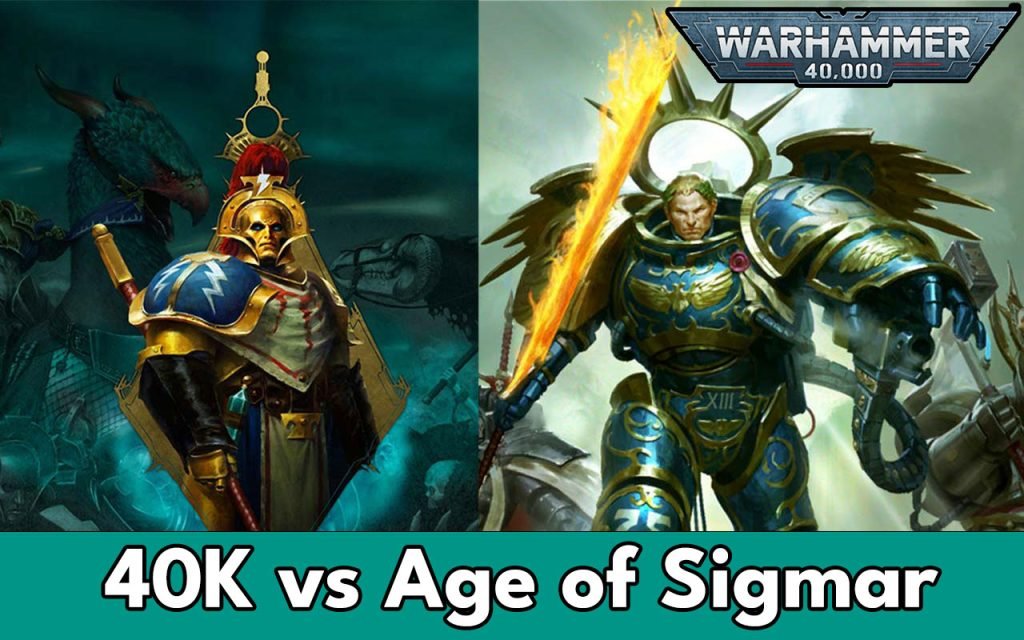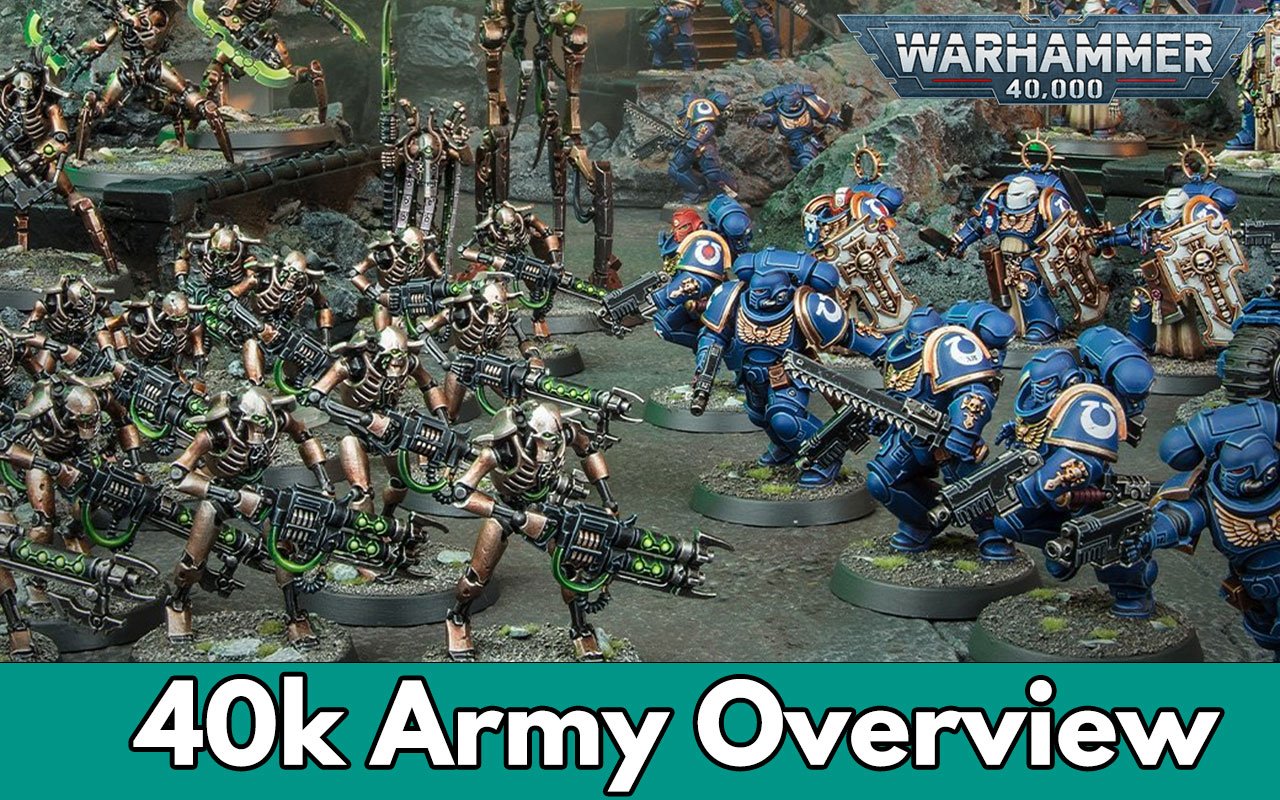La société de jeux de figurines Games Workshop propose actuellement un grand nombre de systèmes de jeu différents, mais la plupart d'entre eux sont liés à leurs deux principaux univers fictifs : la dystopie du futur de Warhammer 40.000 (souvent appelée 40K) et l'univers de haute fantaisie de Warhammer Age of Sigmar (souvent appelé AoS). Les deux univers ont également leur propre jeu de table, où des armées de figurines s'affrontent tandis que les joueurs lancent des dés pour savoir qui l'emportera.
Pour une personne extérieure, et même pour les personnes qui connaissent les décors, les deux jeux peuvent sembler très différents au premier abord, mais au fur et à mesure que vous apprenez les règles et l'histoire des jeux, vous découvrez tellement de similitudes qu'il peut être difficile de savoir quel jeu vous préférez, ou quelles sont les différences essentielles entre les deux.
Dans cet article, nous comparons Warhammer 40.000 et Age of Sigmar. Nous examinons les deux franchises dans des domaines clés tels que leur histoire, les règles de jeu, les différentes factions et l'accessibilité.
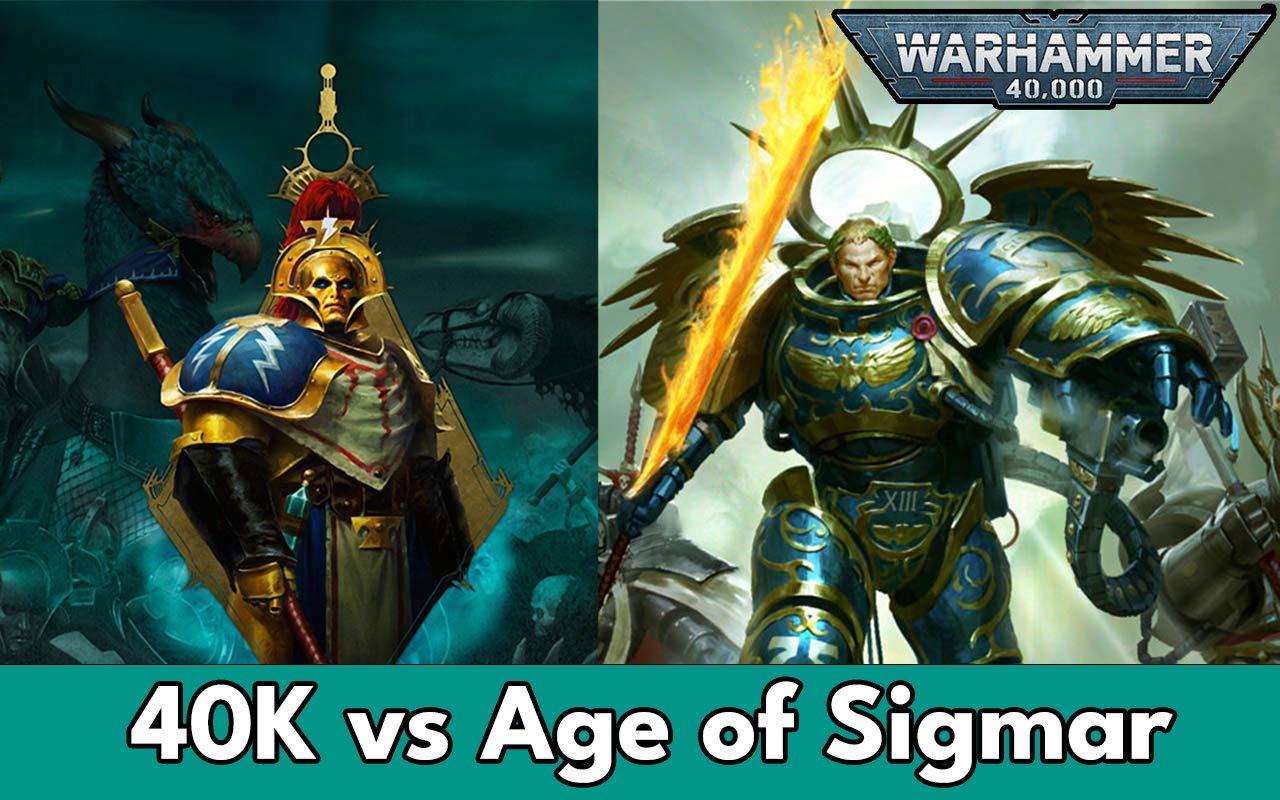
Divulgation des liens d'affiliation
Age of Miniatures est soutenu par ses lecteurs. Lorsque vous achetez par l'intermédiaire de liens sur notre site, nous pouvons percevoir une commission d'affiliation. Pour en savoir plus, cliquez ici.
Histoire, lore et background de Warhammer 40.000 vs Age of Sigmar
Before we go into the lore of each universe, it’s important to just briefly outline the history of the two game systems.
Warhammer 40k est actuellement le plus ancien des deux systèmes de jeu, puisque sa première édition est sortie en 1987, ce qui signifie que ses règles ont connu une tonne d'itérations, et que les écrivains et les artistes construisent son univers fictif depuis plus de trente ans.
Warhammer Age of Sigmar is much younger: It’s only been around since 2015, and in many ways, its still a work in progress, with new factions being added all the time, and while it does have a lot of background story available already, many parts of its universe are still completely up to the players’ imaginations.
Mais : AoS a succédé à un jeu de fantasy plus ancien, Warhammer Fantasy Battles, qui a été créé avant Warhammer 40K, et son histoire est à bien des égards liée à ce jeu, de sorte que l'on pourrait également affirmer qu'AoS est le jeu le plus ancien, du moins en ce qui concerne son histoire.
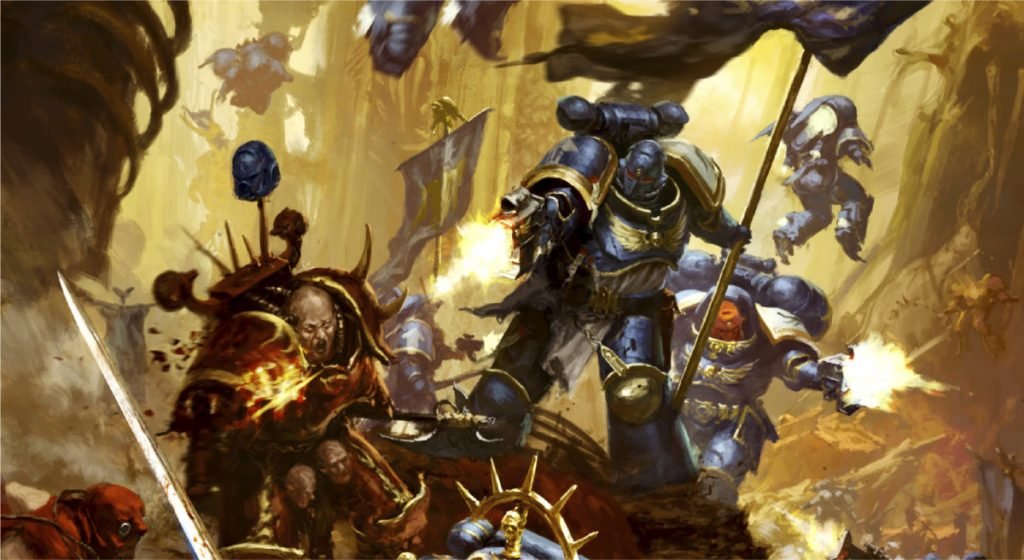
L'histoire de Warhammer 40k
The background history in Warhammer 40,000 goes something like this: In the far future, humankind has colonised countless planets across the galaxy, but we’re very far from a techno-utopian Star Trek scenario or the heroic space fantasy of Star Wars: Things are pretty messed up. Technological progress was largely abandoned after a devastating war against robots and AI, and centuries of galactic civil war ended only when the Emperor of Mankind and his genetically modified supersoldiers united the galaxy under his banner.
Unfortunately, humankind’s troubles were far from over: The Emperor created the Primarchs, his genetically engineered “sons”, to help him rule the galaxy, but the forces of Chaos, mighty daemonic powers that feed off human emotions and desires, first kidnapped them and spread them across the galaxy, and then corrupted some of them after they had been recovered. This led to a galactic civil war between the followers of the Primarch Horus and the Emperor, which ended with the death of Horus and the Emperor being mortally wounded.
L'Empereur survécut, mais seulement sous la forme d'un cadavre à peine vivant enchâssé dans du matériel médical, qui ne pouvait plus parler ni bouger, mais qui pouvait encore projeter ses pouvoirs psychiques dans la galaxie. Les disciples d'Horus et ses Primarques alliés s'enfuirent dans le royaume du Chaos de l'Œil de la Terreur avec toutes leurs forces Space Marine (les supersoldats qui avaient été donnés à chaque Primarque), tandis que les Space Marines loyalistes tentaient de maintenir l'unité de l'Imperium humain.
L'humanité était divisée et affaiblie après cette grande guerre, et était désavantagée pour faire face à tous les autres problèmes d'un empire galactique : D'étranges espèces extraterrestres, telles que les Orks déchaînés ou les anciens Aeldari, attaquaient également les planètes humaines, profitant de l'affaiblissement de l'Imperium.
The 40K game takes place around 10,000 years after all of that went down, and things have gotten even worse. A great rift has appeared in the middle of the galaxy, splitting the Imperium in half, Chaos forces are everywhere, inhuman Necrons and Tyranids are swarming across the galaxy, the advanced T’au Empire is trying to stake its claim as another empire fighting for the Greater Good, and humans with uncontrollable psychic powers are born in ever greater numbers.
L'un des Primarques loyalistes, Roboute Guilliman, est revenu de 10 000 ans de sommeil en stase pour diriger l'Imperium dans une dernière tentative de sauver l'Imperium de l'anéantissement grâce à de nouvelles technologies et à des Space Marines améliorés, mais les forces du Chaos, ainsi que tous les autres prétendants extraterrestres au trône galactique, sont également en mouvement. En gros, tout et tout le monde dans la galaxie est en guerre.
Warhammer 40k Lore est incroyable, et vous pouvez en savoir plus ici..
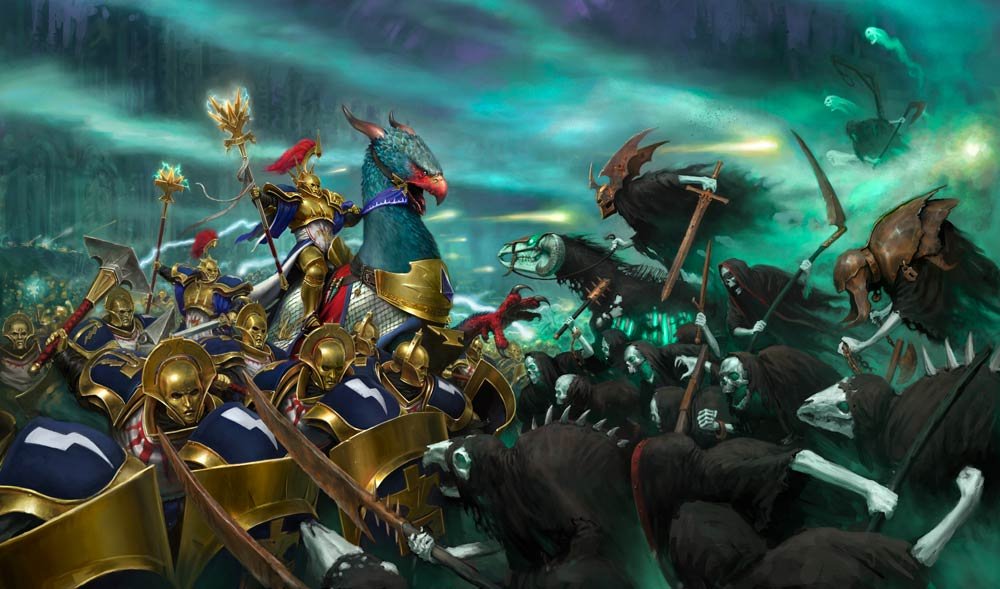
L'histoire de Warhammer : Age of Sigmar
Si l'univers de 40k vise à empêcher la victoire des forces du Chaos, Age of Sigmar adopte plus ou moins l'approche inverse : Tout commence par une apocalypse.
The World-that-Was, an ancien monde where a human Empire (as well as the dwarfs, elves and so on) lost the war against their version of the followers of the same Chaos gods that besieged the Imperium in 40k, was completely destroyed, but the Winds of Magic from that world created new Realms in the void. Many of the gods of the Old World, including the human hero Sigmar who had now become fully divine, had survived to different degrees, and the new Realms were populated in an Age of Myth where great heroes battled mythical monsters and great empires prospered.
Avec le temps, le Chaos s'infiltra à nouveau dans le monde, les désirs et les ambitions des mortels rendant les royaumes vulnérables aux incursions daemoniques. Bientôt, l'âge du mythe fut terminé et l'âge du chaos commença. Sigmar dut se retirer dans son royaume céleste d'Azyr alors que les forces du Chaos déferlaient sur les royaumes et s'emparaient de presque tout sous la direction d'Archaon l'Everchosen, un autre survivant du Monde-qui-était.
Le jeu Age of Sigmar commence le jour où le règne absolu du Chaos sur les royaumes mortels a été brisé : Sigmar a sauvé les âmes mourantes des héros des Royaumes Mortels et les a reforgées en ses propres super-soldats quasi-immortels (ça me dit quelque chose !), les Stormcast Eternals, qui ont été envoyés sur des éclairs pour commencer la reconquête des Royaumes. Au moment où j'écris cet article, les Stormcast Eternals et leurs alliés aelfs, humains, duardin (nains) et séraphons (hommes-lézards) se battent depuis des siècles pour reprendre le monde au Chaos, et bien que de nombreux points d'appui aient été établis, la plupart des royaumes sont toujours gouvernés par le Chaos.
Order and Chaos aren’t the only players on the AOS scene, however: Nagash, the Lord of Undeath, has his own plans to fill the Realms with his undead minions, and he has been a greater danger to both Order and Chaos than they are to each other for most of the recent edition of the game. The wild forces of Destruction, such as the Orruks, Gloomspite Gitz and Ogor Mawtribes are on their own quests for good fights and good food, and even among the forces of Order, there are countless animosities and power struggles.
Si vous souhaitez en savoir plus sur l'histoire de Age of Sigmar, nous vous proposons cet article..
Concepts clés dans les environnements 40k et Age of Sigmar
Ainsi, alors que 40K parle d'un grand Imperium d'Ordre qui perd son emprise, AoS parle de l'Ordre et d'autres puissances qui tentent de reprendre le pouvoir aux forces du Chaos.
En dehors de cela, il existe de très nombreuses similitudes entre les univers de jeu, dont les principales sont les suivantes :
- Le chaos : Dans les deux univers, les Forces du Chaos sont les principaux antagonistes de la civilisation, et elles sont dépeintes de la même manière : Les dieux communs aux deux univers sont Nurgle, le dieu de la décomposition, Tzeentch, le dieu du changement et de la magie, Khorne, le dieu de la rageet Tzeentch, le dieu de la démesure. Dans AoS, il y a aussi le Rat Cornu, le Dieu du Chaos des hommes-rats skavens. Dans les deux univers, ces Dieux du Chaos se battent entre eux et contre d'autres forces.
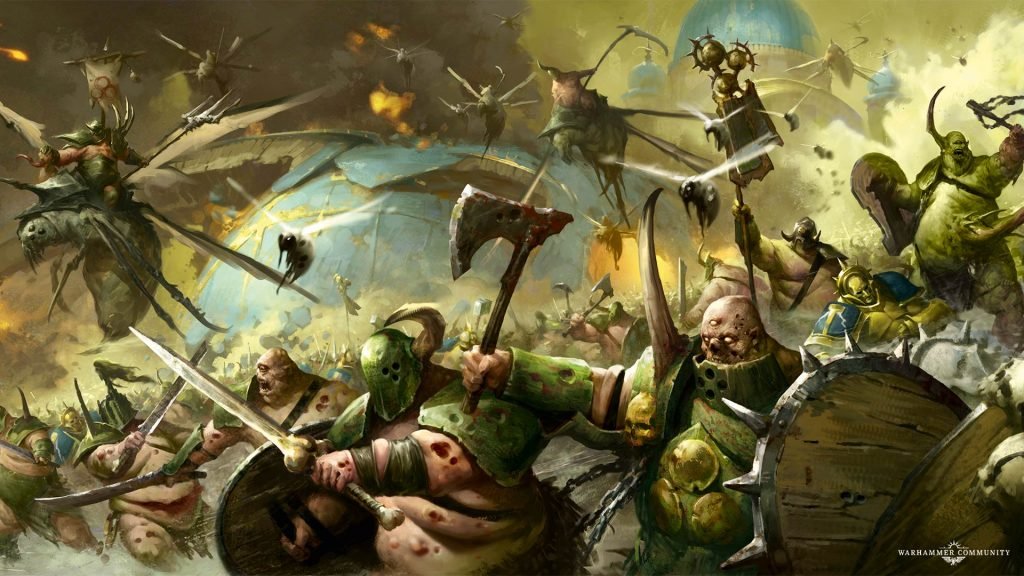
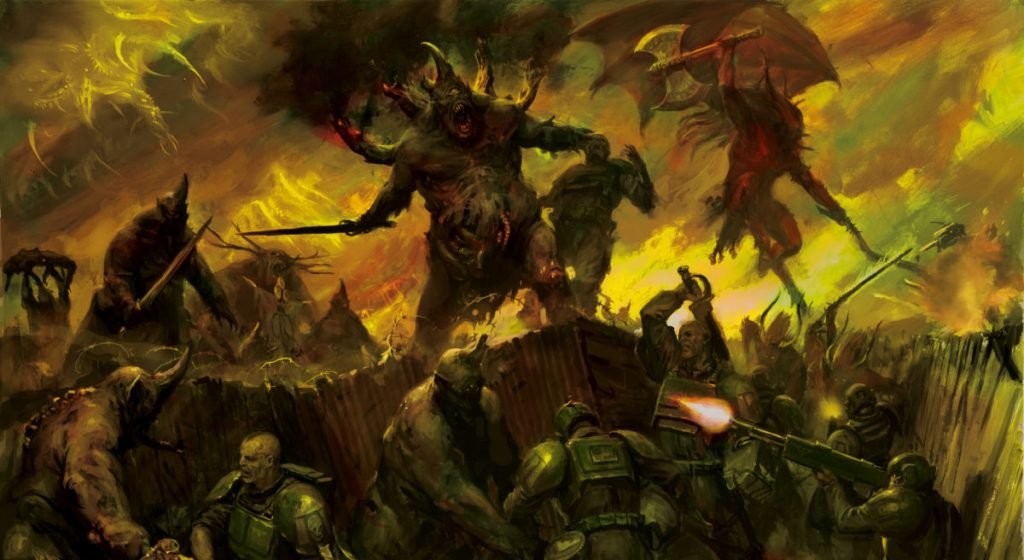
- Fantasy “races”: Both universes have versions of classic Tolkienesque fantasy species such as elves, dwarves, and orcs: In 40K they have just been changed into futuristic space versions of themselves, so dwarves are now evolved humans called Squats, orcs are Orks who have an empire of their own without a dark overlord, and elves are the ancient Aeldari who are just as nostalgic and in decline as the elves of Tolkien’s works. In Age of Sigmar, most of those species are there in their fantasy forms, but redesigned to distinguish themselves from fantasy cliches: Dwarves are now duardin, and some of them are now steampunk privateers in flying ships, while others are gold-seeking mercenaries. Elves are now aelves who exist in a myriad of forms, from the aquatic Idoneth to the murder-worshipping Witch Aelves, and orcs are Orruks who hunt beasts to gain power or fight in heavy armour as the Ironjawz. 40K even has its own versions of the Undead in the shape of the metallic Necrons who look just like metallic skeleton warriors.

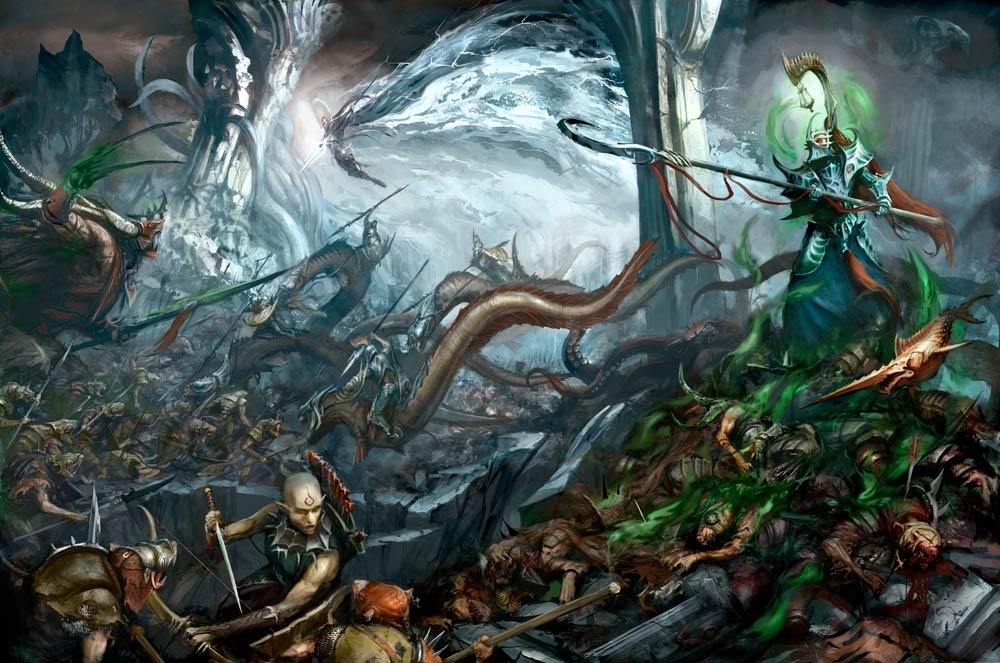
- Fraternités guerrières monastiques : Both universes have protagonists who belong to monastic orders of super-powered warriors. in 40K, they’re the Space Marines: legions of supersoldiers who serve the Emperor, but with great differences between the cultures and strategies of each Chapter. In AOS, they’re the Stormcast Eternals who serve Sigmar in the reconquest of the Mortal Realms, but with great differences between the cultures and strategies of each Stormhost. They’re not exactly the same, though, as the Stormcast Eternals have their own distinct story of being dead heroes resurrected, dying and being resurrected again constantly, until they can barely remember what being human is like, while the Space Marines are mortal, but can live for centuries if they survive the wars they wage. The Space Marines are also exclusively male and are recruited at a young age, while Stormcast Eternals have lived full lives before being reforged, and aren’t exclusively male.

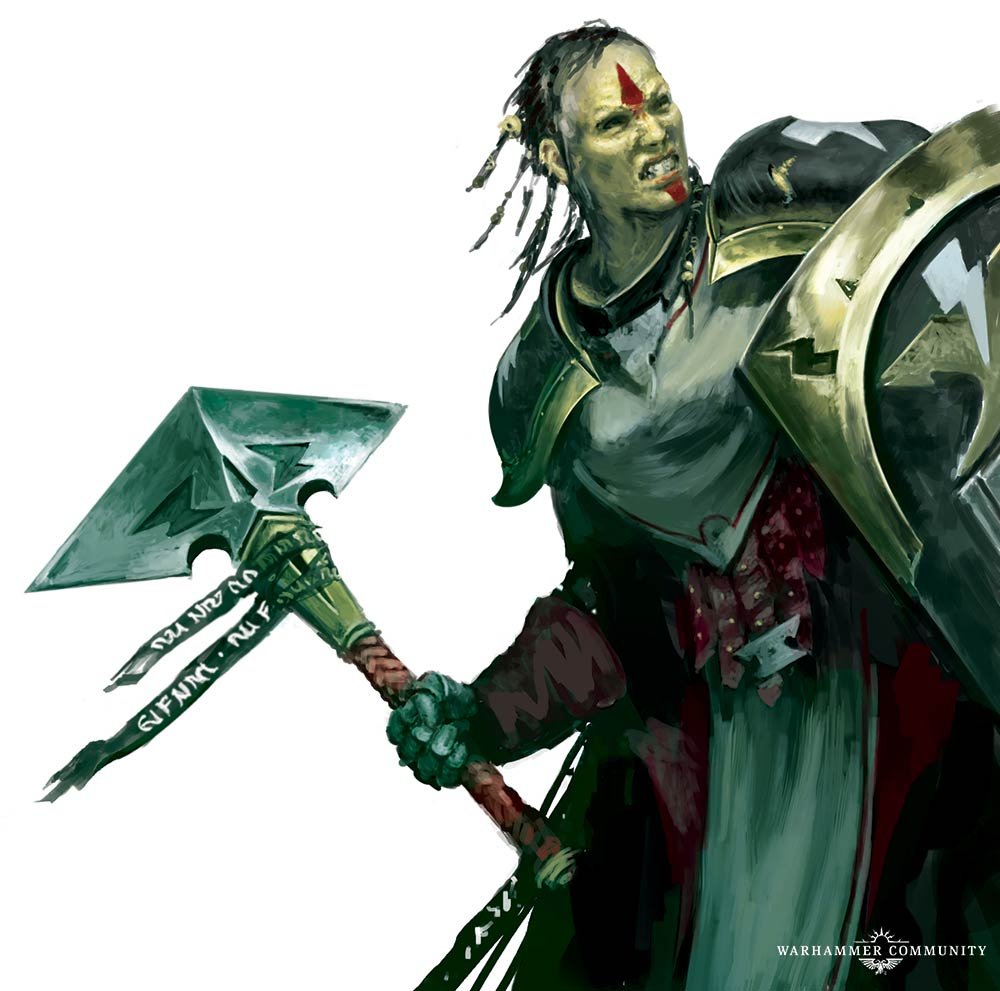
- Magie: In 40K, magic is there in the form of psychic powers and the psykers who are able to use them. All psychic powers draw their power from the chaotic Warp, so they’re very dangerous to use, and may backfire on their wielders. The unsanctioned use of psychic powers is forbidden in the Imperium, and psykers are hunted down. In AoS, magic is literally everywhere: Each Realm is made up of a particular form of magic (Life, Death, Light, Metal and so on), and the world is a wild an unpredictable place where supernatural stuff happens all the time. Every faction uses magic: Even the technological Kharadron Overlords have figured out how to steal spells from other factions and bottle them, and if an army isn’t fielding wizards, it’s probably fielding priests that can pray for magical powers from their gods.
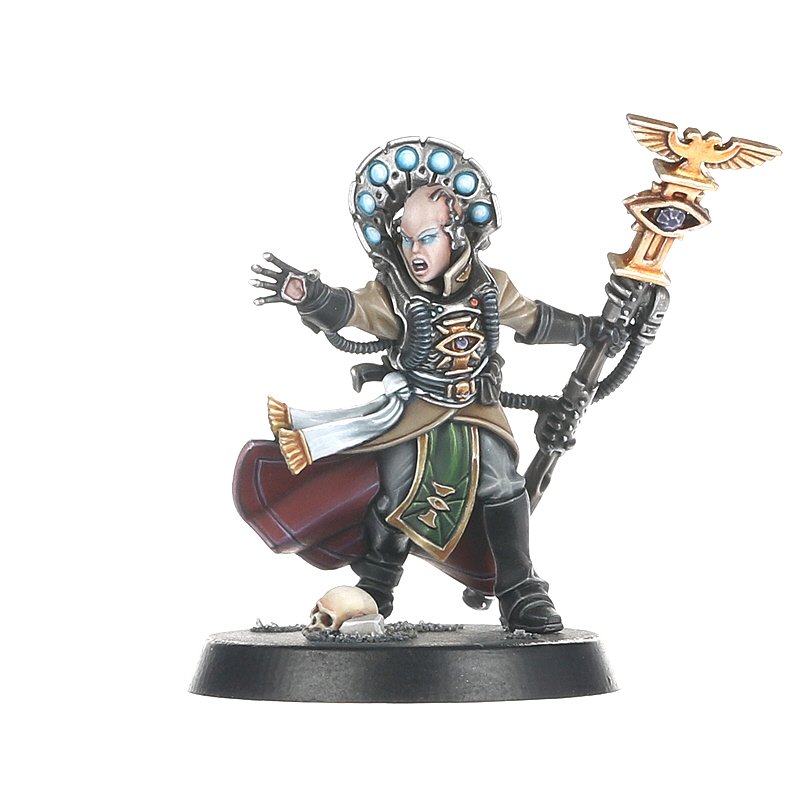
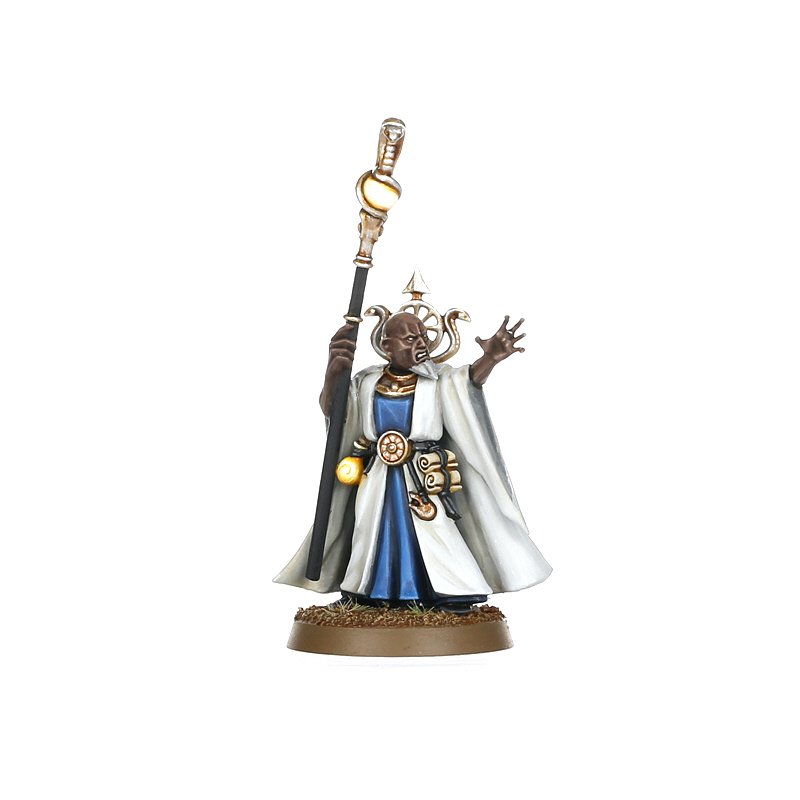
- Technologie : In 40K, much of the technology is advanced compared to our present, but innovation and progress is something that’s generally reserved for the T’au Empire and radical visionaries in the Imperium. Most of the time, nobody remembers why anything works the way it does, and superstition is abundant, as priests chant prayers to fix broken tank engines and bless weapons with attached strips of holy Scripture. In AoS, technology plays a very big role for a fantasy game: Sigmar’s reconquest of the Realms is powered by technological innovation to a very large degree, and the Stormcast Eternals carry various magical “guns”. The Free Cities are also often very industrial and use mechanical devices for many purposes, and the duardin Kharadron Overlords have so much technological weaponry that they can go toe to toe with wizards and Chaos Daemons and emerge victorious.
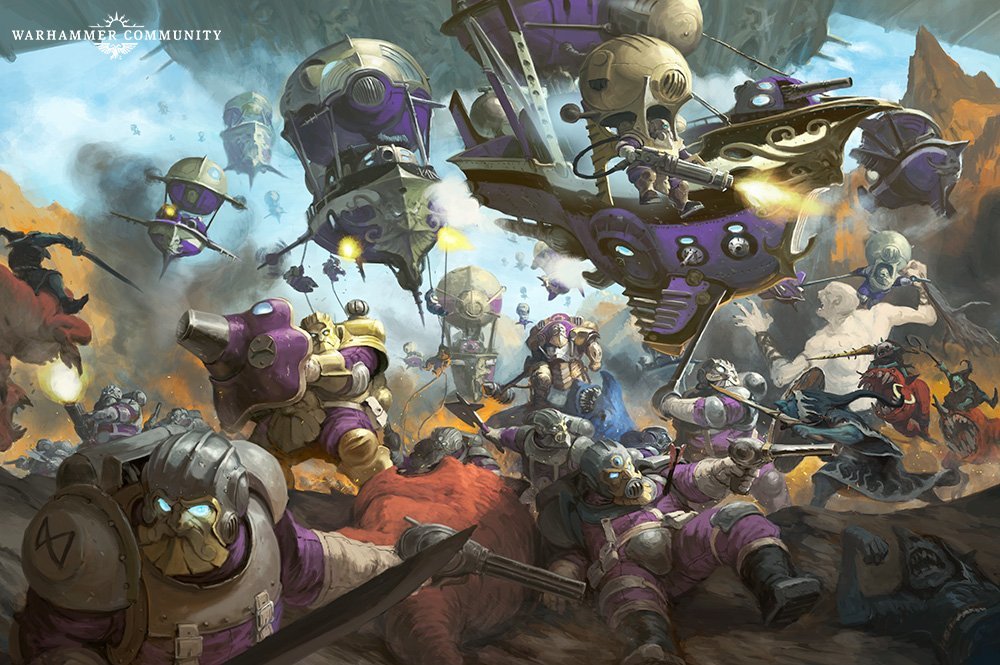

Différences de règles entre Warhammer 40.000 et Age of Sigmar
Les règles de jeu d'AoS ou de 40K sont probablement celles qui se ressemblent le plus entre les deux systèmes. En fait, ils se ressemblent tellement qu'il peut être difficile pour un débutant de repérer les différences jusqu'à ce que les figurines commencent à se battre l'une contre l'autre. De plus, si vous jouez aux deux systèmes, il est très fréquent d'oublier quelles règles s'appliquent à quel système. Nous avons une description détaillée des similitudes et des différences dans chaque phase d'un tour pour les deux jeux dans notre Warhammer 40,000 Recruit Edition Critiquemais cette section met l'accent sur les points les plus importants.
Tours, rondes et phases
Les deux jeux fonctionnent par tours, rondes et phases. Chaque tour consiste en un tour pour chaque joueur, et chaque tour consiste en un certain nombre de phases pour chaque jeu :
40K :
- Phase de commandement : Les points de commandement sont gagnés et certains effets sont résolus
- Phase de mouvement : Les unités se déplacent
- Phase psychique : Les pouvoirs psychiques sont utilisés et l'adversaire peut tenter de les arrêter.
- Phase de tir : Les unités dotées d'armes à distance tirent
- Phase de charge : Les unités chargent au combat
- Phase de combat : Le combat au corps à corps est résolu. Les unités qui ont chargé combattent en premier, puis les joueurs alternent pour que toutes les unités à portée de mêlée combattent.
- Phase de moral : Les dés sont lancés pour vérifier si des figurines fuient.
AM
- Phase des héros : Certaines capacités de commandement sont utilisées, des sorts sont lancés et contrés.
- Phase de mouvement : Les unités se déplacent
- Phase de tir : Les unités dotées d'armes à distance tirent
- Phase de charge : Les unités chargent au combat
- Phase de combat : Les unités à portée de mêlée s'attaquent alternativement l'une l'autre.
- Phase de combat : Les dés sont lancés pour vérifier si des modèles fuient.
Comme vous pouvez le constater, le déroulement d'un tour est très similaire dans les deux jeux, avec de légères variations. A grand difference is that in 40k, players roll off to see who gets the first turn (if they want to take it), and then alternate taking turns. In AOS, players roll off to see who gets the first turn before every round of the game, which means there’s an opportunity to take two turns in a row if you were last in the previous round. This is hotly debated in the AOS community because some players think this means the player who gets a double turn has too good a shot at winning the game, but it seems to be there to stay.
Mouvement
Le mouvement dans les deux jeux est très similaire, mais dans 40K, les modèles d'une unité doivent terminer leur mouvement à moins de 2 pouces les uns des autres, contre 1 pouce dans l'AM, ce qui signifie en fait pas mal de choses pour la façon dont vos armées sont organisées !
Frapper, blesser et subir des dommages
Here’s one of the really major differences between the two game systems: In AOS, each weapon on a warscroll has a fixed chance to hit and to wound, for example 3+ to hit and 4+ to wound. In 40K, these two stats are ruled by separate systems. The chance to hit is not tied to the weapon, but to the model, and is represented by a Weapon skill (for melee combat) and a Ballistic skill (for ranged combat). The chance to wound is much more complex, since you figure this out by comparing the Strength of the attacker (for melee) weapon modifiers or the Strength of the weapon (for ranged combat) to the Toughness of the target. If your Strength is higher than the target’s Toughness, it’s easier to wound them, and if it’s lower, you have to roll much higher to wound.
On top of this, weapons in 40K have types that can determine how they work in the game, such as Rapid Fire weapons which can double their attacks if they are within half their maximum range of the target. Also, weapon damage in 40K doesn’t carry over, which means that if your weapon has a damage characteristic of 2 and kills a 1 wound enemy model, the surplus 1 point of damage is just lost. In AOS, a damage total is just applied to the enemy unit, so a damage 2 weapon would be able to kill 2 1 wound models.
En bref, 40K a un niveau de simulation plus élevé que l'AOS en ce qui concerne le combat : il y a différents types d'armes, les armes à dégâts multiples sont en fait plus utiles contre des cibles plus grandes que dans l'AOS, et les armes de mêlée prennent en compte la force du manieur. Cela rend le jeu plus complexe (et plus lent !), mais ajoute également une couche tactique qui manque à AOS dans ce domaine du jeu.
Rôles des unités
Dans AoS, il y a les rôles d'unité suivants pour la construction de listes (il y a plein d'autres mots-clés !) :
- Leaders – these are your heroes and single characters
- Battlelines – these are your standard troops, and you usually need a few of them to build a list
- Artillery – these are you artillery units
- Behemoths – these are very large models that you can only field a few of
- Other Units – this is everything else
Dans 40K, il y a les rôles d'unité suivants pour la construction de listes (mais il y a bien sûr beaucoup d'autres mots-clés) :
- HQ – these are your heroes and leaders
- Troops – these are your standard troops
- Elites – these are elite troops, but can also be single models that don’t function as leaders
- Fast Attack – these are fast-moving troops
- Flyer – These are flying units (which have special rules in the game)
- Heavy Support – these are heavy ranged units
- Dedicated Transport – these are unit transports
- Fortification – these are stationary, building-type models
- Lord of War – these are super-warriors such as Primarchs, and comparable to the power levels of gods in AOS
Points de commandement
Both games have command points which can be used to activate abilities, but they also interact with the games in other ways when it comes to list-building, as we’ll go through below. In AOS, these abilities are tied to Leaders, whereas the Stratagems of 40K are a system of their own and not specifically tied to characters.
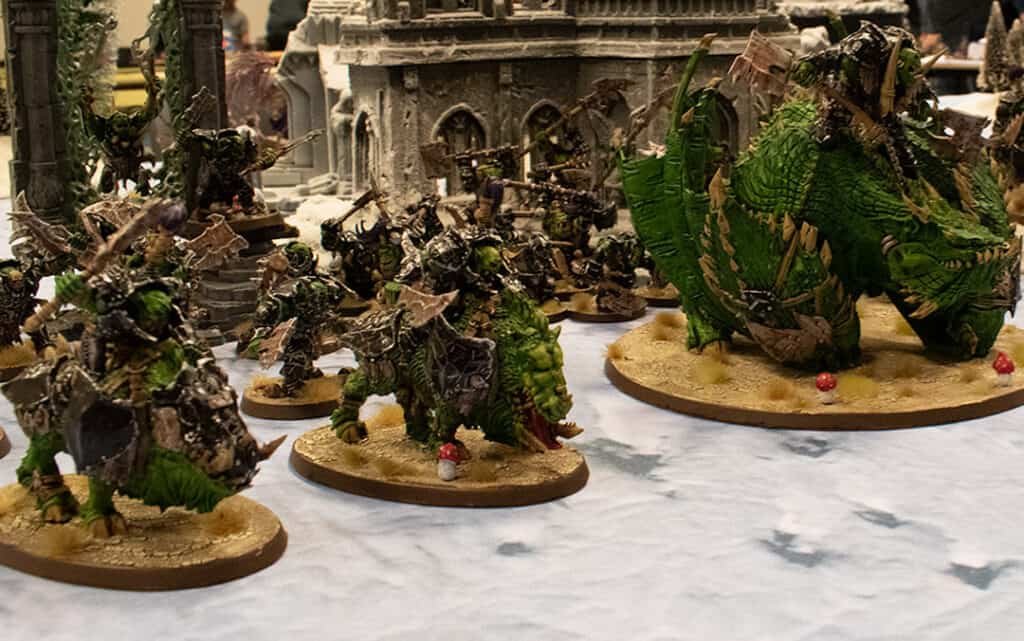
Construire des listes d'armée dans 40k vs Age of Sigmar
En Matched Play (le format des parties compétitives), les deux jeux ont un coût en points pour chaque unité et une limite de points pour ce que vous pouvez aligner dans une partie. En dehors de cela, les règles de construction d'une liste d'armée dans les deux jeux sont assez différentes.
Dans 40K, le niveau de points auquel vous choisissez de jouer vous donne des points de commandement, que vous pouvez ensuite utiliser pour acheter des détachements. Les détachements sont des groupes d'unités dans lesquels vous devez amener un certain nombre d'unités ayant un rôle spécifique, mais vous pouvez également amener d'autres types d'unités. Si vous parvenez à placer toute votre armée dans des détachements, vous obtiendrez divers bonus. Les armes spéciales pour les unités peuvent avoir leur propre coût en points supplémentaires.
Dans l'AM, un niveau spécifique de points vous oblige à prendre un nombre spécifique de chefs et d'unités de la ligne de bataille, et fixe ensuite des limites pour les autres types d'unités que vous pouvez emmener. Vous pouvez également acheter des bataillons en échange de points. Un bataillon est un groupe spécifique d'unités qui vous accorde divers bonus, tels qu'un point de commandement supplémentaire et la possibilité de prendre un artefact supplémentaire pour l'un de vos chefs.
It’s definitely more straightforward to build armies in AOS, but the detachments of 40K also guides you in building armies that are good at specific things, which is a different, but good way of guiding beginners in building army lists. You can read more about army building in AOS and 40K in our beginner’s guides for the two games.
Campagnes
in AOS, the campaign system is called Path to Glory, and it lets you slowly build an army through playing games and earning points that you can then use to add more units and give them bonuses. This is a cool system, but the recent edition of 40K has introduced a Crusade system that’s a big evolution of the Path to Glory system with dedicated books, bonuses and much more ways to develop your characters and units. Hopefully a new edition of AOS will adapt something like this, but for now, it seems like 40K is in the lead when it comes to campaign systems.
Factions dans Warhammer 40.000 vs Age of Sigmar
40K a environ 30 armées disponibles (cela dépend de la façon dont vous comptez les chapitres Space Marines), divisées en trois catégories générales : Armées de l'Imperium, Armées du Chaos et Armées Xenos. Vous pouvez les découvrir sur notre page de présentation des armées 40k.
AoS a environ 24 armées disponibles (mais leur nombre ne cesse de croître) divisés en 4 grandes alliances : Ordre, Chaos, Mort et Destruction. Vous pouvez en savoir plus sur chacune d'entre elles dans notre guide de présentation des armées de l'AM et dans notre guide de présentation des armées de 40k.
De quoi avez-vous besoin pour commencer à jouer à Warhammer 40.000 vs Age of Sigmar ?
Pour les deux jeux, vous avez besoin des mêmes éléments pour commencer, mais il y a quelques différences essentielles.
Si vous souhaitez approfondir l'un ou l'autre des deux jeux, nous avons une Beginner’s guide for Age of Sigmar ici et un Beginner’s guide for Warhammer 40k ici.
Miniatures

First of all, you will need some miniatures to play the game. Games Workshop makes some of the most highly detailed plastic miniatures in the business, and they’re pretty easy to assemble and paint. With very few exceptions, every single unit you can field in both games have a corresponding box of miniatures you can buy from Games Workshop. They are also sold by a ton of different hobby stores, both physically and online.
Exactly which miniatures you want to buy depends entirely on what army you’re playing, of course, and which list you’re building.
Coffrets de départ et les différentes grandes surfaces sont souvent le seul moyen d'économiser de l'argent lors de l'achat de modèles neufs.
Dés
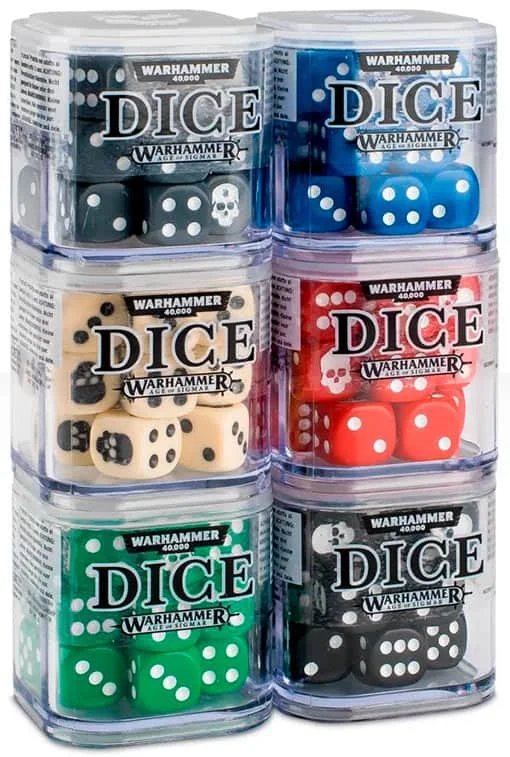
Both games use only six-sided dice, and you can use whatever versions of these you want. Many factions have faction-specific dice designed with their iconography, but that doesn’t influence the game at all, so just use any dice you have. It’s a good idea to have many of them (you can often find a use for more than 30 of them), and to have dice in different colours, so you can roll different attacks with the same chance to hit, but with different chances to wound, at the same time in a hit roll.
Achetez donc en gros et obtenez des tas de dés !
Ruban à mesurer

Les deux jeux mesurent la distance en pouces, donc n'importe quel mètre ruban mesurant des pouces convient.
Paysage
Games Workshop propose de nombreux décors en plastique pour 40k et l'AM, ainsi que des règles pour les utiliser dans le jeu. Certaines factions des deux jeux disposent même de décors spéciaux qui donnent des bonus à votre armée. Vous pouvez toutefois utiliser des décors tiers, des boîtes en carton et des briques LEGO si vous le souhaitez.
Les terrains en plastique de GW ont l'air bien, mais il peut être très coûteux de remplir un plateau avec uniquement des terrains GW. Il n'y a pas de mal à chercher des terrains moins chers.

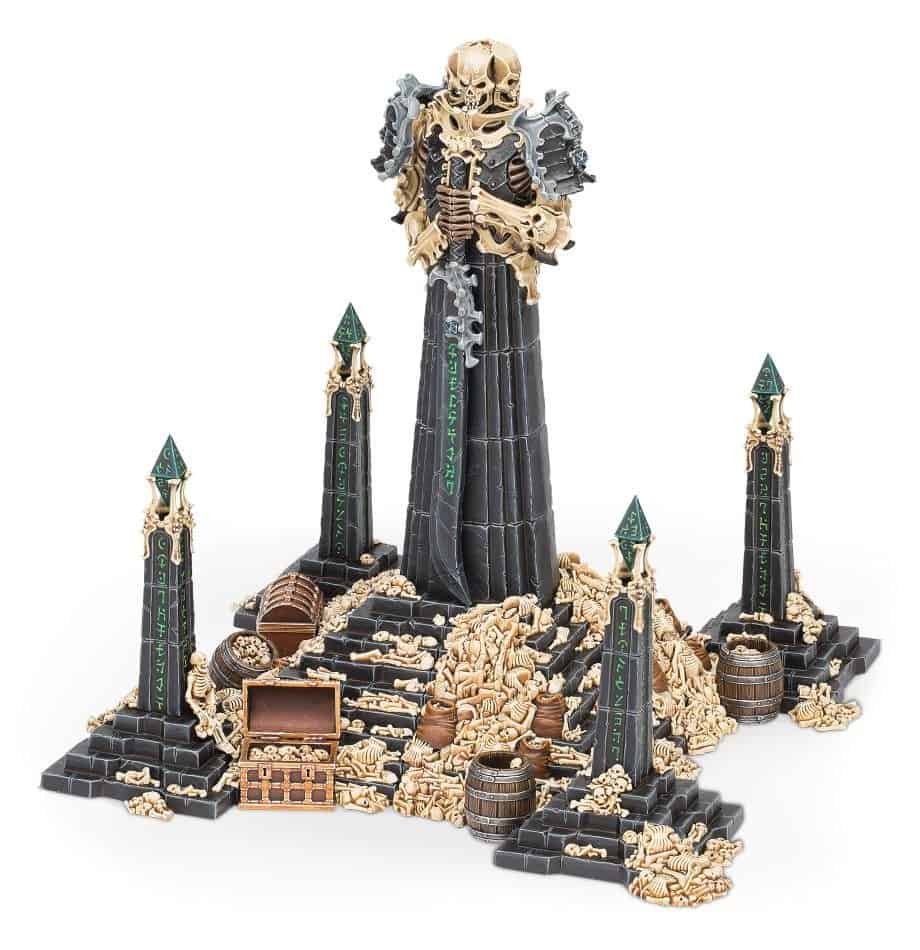
Règles
Règles de base
Les règles de base peuvent être téléchargées gratuitement pour les deux catégories suivantes 40K et AM – but they’re only the tip of the iceberg. You can absolutely play the games with these rules and some unit rules, but sooner or later you’ll need a rulebook.
Pour 40K, ce qu'il vous faut, c'est le Warhammer 40,000 Core Rulebook, which has all the rules you’ll need, as well as a very detailed introduction to the game’s universe and lore. Be aware that this book is only available in a physical format (so not as an e-book, which seems to be the case for everything released for Warhammer 40,000 since the release of its 9th edition in 2020) and that, for some unfathomable reason, it’s not included in any of the starter sets for the game.

If you want to play with the most up to date rules, you’ll also need the latest version of the Chapter Approved Grand Tournament rules, which contains updates to the rules as well as points updates (now in a separate book called the Munitorium Field Manual).

Pour l'AM, vous avez besoin du fichier Age of Sigmar Core Book, which also contains complete rules and lore for the game. It’s available in both physical and digital form (like all AOS publications)

You’ll also want to buy the General’s Handbook 2020 (or the one for whatever year you’re reading this article), which contains updates to the rules as well as the battleplans and rules that will be used for tournaments and competitive play in that year.
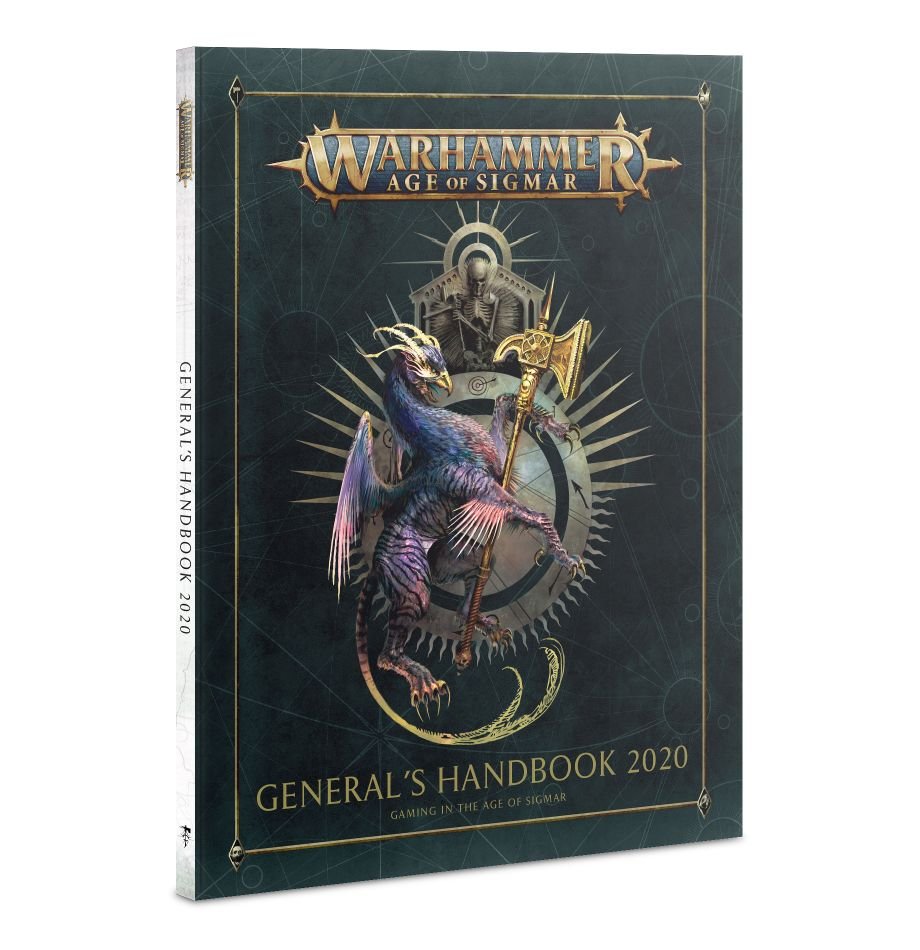
Règles de l'unité
En ce qui concerne les règles applicables à chaque unité que vous souhaitez aligner, les deux jeux sont assez différents.
In 40K, unit rules are printed on datasheets, which are generally found in codexes. A codex is the book each army in the game has for all its rules and lore. So if you want to field a unit with its full rules, you need the codex for the army it’s from. When you buy a box of miniatures for the game, that box will also contain a basic datasheet for the units you can build with that box, but it might not include all options available to that unit.

In AOS, unit rules are printed on warscrolls, which are freely available to download from the Games Workshop webstore under the page for each box of miniatures available in the game. A unit will generally not have options available to it that aren’t printed on its downloadable warscroll. This means that you can play the game with just those rules, miniatures and the warscrolls in the miniature boxes, but in most cases, you’ll also want the battletome for the army you’re playing. A battletome contains all the lore and special rules for an army you can field in the game, as well as the warscrolls for units from that army.

Applications
L'AM et 40K ont tous deux des applications disponibles pour iOS et Android. L'utilité de ces applications est cependant assez différente.
Warhammer 40,000 : L'application is a very good army builder that helps you keep track of all the different choices you have when building a 40K army. It does require a paid subscription though, but it’s around the price of a bottle of soda, so that’s negligible. The main problem with the 40K app is how it is tied to physical books. You can only access the full rules for units for which you have an actual physical codex, since you need a code that’s printed in the back of each physical book. This means that even though you have the paid subscription, you still need to go out and buy physical books to take advantage of the functions in the app.
For now, there are still many armies that haven’t had a new codex released for them for the 9th edition of the game, and as long as an army doesn’t have a codex, you can use all its rules straight from the app! Check our 40k faction overview to see which armies have a codex.
The digital publishing strategy for 40K is a big drawback if you want to start playing the game, especially since new codexes are often sold out, and then there’s just no way of getting the rules for your army.
Inversement, le Warhammer Age of Sigmar Application has all the warscrolls for all units in the game available, even without a subscription, while the option to build army lists costs a small monthly fee. You still need battletomes to access special army rules such as allegiance abilities and subfactions, but the battletomes are all available to buy in the app, in addition to General’s Handbook and other rules publications.
Nobody really knows why the two apps and their associated digital sales strategies are so different, but what they have in common is quite a few bugs, so if you run into the rules for a unit being wrong or a specific option missing, don’t be too surprised. All that being said, both apps are very useful tools for beginners and veterans alike.
Avantages et inconvénients de Warhammer 40.000 vs Age of Sigmar
40K
Pour :
+ Huge backstory that’s been developed for decades
+ …and so has its rules
+ un niveau de complexité et de simulation des combats et de la constitution des listes supérieur à celui de l'AM
+ has a huge community, so it’s easy to find someone to play with
– slower than AOS
– much of the game is very tied to tradition, so new armies don’t appear as often
– lack of digital availability of rulebooks can make the game hard to get started with
AOS :
+ Un monde nouveau, frais, où tout est possible
Les règles + accessibles facilitent la prise en main du jeu.
+ de nouvelles armées apparaissent en permanence
+ the “everything is on the warscroll” approach means there is room for more imaginative, wild unit abilities
+ rapide que 40K (pas de force/travail à calculer, par exemple)
– is still growing as a game, so it’s hard to figure out what’s good or bad in the game because the next battletome might turn everything on its head
– advanced players might miss the levels of weapons and combat simulation from 40K in AOS

